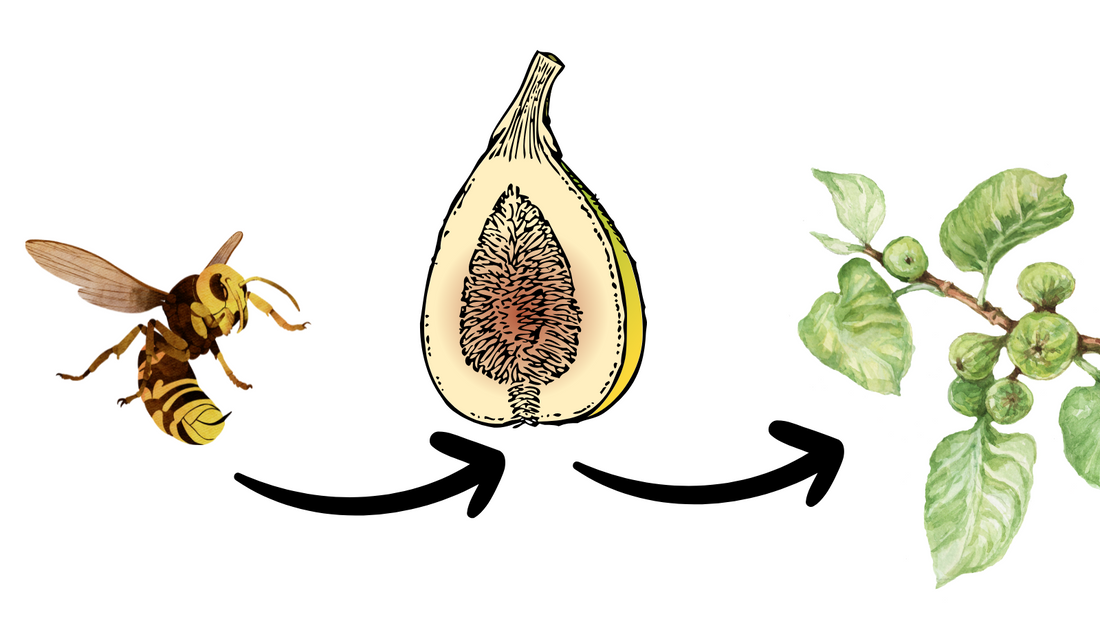On previous blogs we've explained why the 'common fig' varieties on our site don't require pollination by a fig wasp, and that you don't need to plant multiple trees to get fig production from our varieties. But I did want to further explain the fig wasp pollination process just because it's so neat and a perfect example of nature working together. So here we go!
The relationship between the fig wasp and native fig trees is quite amazing. It's a perfect example of mutualism, where two species (the wasp and the fig) benefit from the relationship between the two. The fig wasp helps the fig tree by pollinating the figs, and the fig tree helps the wasp by providing a habitat for reproduction.
The Fig Wasp
Let's start by explaining more about the fig wasp. The fig wasp is not like the typical wasp you may see building nests around your garage or barn. The fig wasp is much smaller and belongs to the genus Pegoscapus. These wasps have to be small, otherwise they wouldn't be able to fit inside the tiny hole at the bottom of the fig -- called the ostiole.
Each native species of fig is said to have its own species of wasp that pollinates the figs. That makes this whole process even more incredible. Without the fig wasp, the native fig tree doesn't reproduce. And without the figs, the fig wasp doesn't reproduce.
The Fig Pollination Process
When figs start to develop on a native tree, they emit an aroma that attracts the female fig wasp that is presumably nearby. This female fig wasp was born inside a fig, so she should already have fig pollen on her body. When the fig enlarges, the female fig wasp is able to enter the fig through the hole in the bottom called the ostiole.
As the female fig wasp enters the fig, her wings will be damaged or removed completely. But that's okay -- she won't need them any longer. The female fig wasp proceeds to crawl inside the fig and lay her eggs.
In the process, she is also spreading pollen from the fig in which she was born. Recall that a fig is not technically a fruit, but an inverted flower structure called a 'syconium.' This pollen transfer pollinates the current fig as male pollen is transferred to the female parts of the flower inside the fig.

The Wasp Reproduction Process
The fig is now pollinated, so what's next for the wasp? Once the female lays eggs inside the fig, she will die. But her biological legacy continues as her eggs hatch inside the fig!
Male and female offspring will hatch from those eggs. The males won't have any wings, but they don't need them because they never leave the fig. The males mate with the females inside the fig, continuing the circle of life.
Once the males mate with the females, the males will begin to create tunnels for the females to exit the fig. Once they've created an exit strategy for the females, the male wasp dies inside the fig. The female wasps, who do have wings, will exit the fig via the tunnels created by the males. With fertilized eggs "in hand," the female fig wasp will now search for another fig to lay her eggs and the cycle continues.

Everyone Has to Do Their Part
From an animal behavior perspective, mutualistic relationships like this are susceptible to "cheating." What if the wasp didn't carry pollen to the next fig and only used the fig to lay her eggs? What if there was no benefit to the fig at all?
But something very interesting here happens if the wasp doesn't do her part in the mutualistic relationship. A study from Cornell found that if the wasp did not bring pollen to the fig where she would lay her eggs, the trees would drop the figs.
Dropping the figs would kill the wasp eggs inside it and break the cycle. So there's certainly a consequence for cheating! The fig wasp must do its part and provide the pollen that the fig tree needs. If it doesn't, the fig tree doesn't do its part and continue to provide a home for those eggs to hatch.
What Happens to Those Dead Wasps?
Unless you visit the Middle East, the chances of you eating a wasp-pollinated fig are pretty rare. But if you did, would you be eating dead wasps as well? The process we described above suggests that each fig would have at least one dead female wasp inside it and a bunch of little dead male wasps.
Luckily for you, figs also contain a digestive enzyme called ficin. This enzyme breaks down the wasp bodies inside the fig and converts them into a protein. The crunch sensation you get from eating a fig comes from the seeds inside the fig, not dead wasps.

